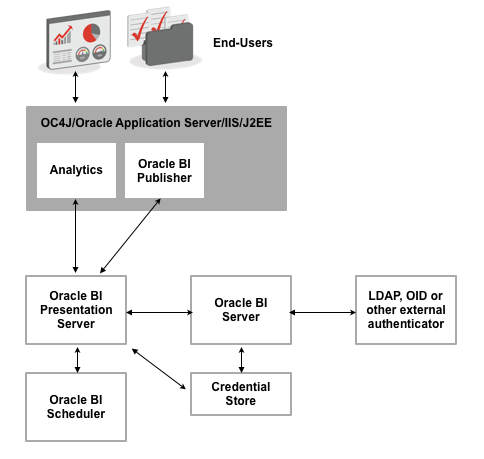OBIEE Architecture :
In previous articles i have explained about the advantages of OBIEE,What is Business Intelligence?.I also explained what exactly the facts and dimensions in table and gives the idea about the Star schema and snowflakes schema as well.In this article i will try to explain about the OBIEE Architecture as well as the different components of OBIEE.I will try to explain how the OBIEE works internally after client sends the request to server.Before we start with the OBIEE Architecture we need to know what are different components of Oracle Business Intelligence Enterprise Edititon(OBIEE).
OBIEE Components :
OBIEE is working on request-response mechanism so OBIEE has 2 types of components:
1.Server Components
2.Client Components
1. Server Components :
Server components are components which are responsible to run the OBIEE Systems.There are following OBIEE Server components:
1.Oracle BI Server
2.Oracle Presentation Server
3.Application Server
4.Scheduler
5.Cluster Controller
2. OBIEE Client Components :
Client components are those which interacts with user to create reports and dashboards.Following aare important client components of OBIEE :
- Dashboards
- Oracle Delivers
- BI Publisher
- BI Presentation Service Administrator
- Answers
- Disconnected Analytics
- MS Office Plug in
HOW OBIEE WORKS ?
As Shown in following diagram initial request of end user is sent to presentation server. Then servers works as follows :
1.Presentation server : The presentation server is responsible to convert the request comes from end user to logical SQL and sends it to Oracle BI Server.
2.Oracle BI server :The main task of Oracle BI server is converting the logical sql to Physical sql so that database will understand the sql. Oracle BI server converts the logical sql to physical sql so that database syntactically identifies the query and send it to the Database.
3.Database : Database fetches the required result.
OBIEE Architecture :

OBIEE Architecture contains 2 types of components :
- Java components also known as Weblogic Server Components.
- Non Java Components also known as Oracle BI system components.
1.1. Weblogic Server :
a. Admin Server :
Admin server is further categories in to Admin console and Enterprise manager.
Admin server is responsible to start or stop the processes of managed server.
b. Managed Server :
Managed server is responsible to handle BI Plug in,Security mechanism,BI Publisher,
SOA and BI office e.t.c.
1.2. Node Manager :
Node manager is responsible to start or stop or restart the activities.
It also provides process management activities to admin and managed servers.
1.3. Oracle Process Manager Notification Server (OPMN) :
OPMN is responsibe to start and stop all the following BI components :
1.Oracle BI Server :
1.1. Oracle BI server is heart of OBIEE system and is responsible to communicate with other OBIEE components.
1.2. It generates a query and send it to database server to fetch results.
1.3. It is responsible for managing the Repository components (RPD components) for report generation.
1.4. Oracle BI Server handles security mechanism as well as multi-user environment.
2. Oracle Presentation Server :
2.1. It takes user via browser and sends all the requests to OBIEE Server.
3. Application Server :
3.1. Application serer helps to work with client components like dashboards,answers e.t.c.
4. Scheduler :
4.1. Scheduler is responsible to schedule the jobs in repository.When you create Repository then OBIEE internally creates a table in repository which saves all schedule related information.
4.2. Job Manager is responsible to manage all scheduler related information.
5.Oracle BI Cluster Controller :
5.1. Oracle BI Cluster controller is responsible for load balancing on server.
5.2. It ensures the load is evenly assigned to all BI server process.
Hope everyone gets the idea about the OBIEE Architecture and understands the components of obiee and its usages.
